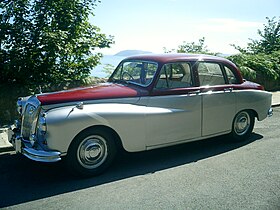| Daimler Majestic DF316 | |
|---|---|
 | |
| Overview | |
| Manufacturer | The Daimler Company Limited |
| Production |
|
| Assembly | United Kingdom: Coventry, England |
| Body and chassis | |
| Class | Luxury |
| Body style | Four-door Saloon |
| Related |
|
| Powertrain | |
| Engine | 3.8-litre in-line 6 |
| Transmission | Borg-Warner Automatic |
| Dimensions | |
| Wheelbase | 114 in (2,900 mm) [1] |
| Length | 196 in (5,000 mm) [1] |
| Width | 70.5 in (1,790 mm) [1] |
| Height | 63 in (1,600 mm) [1] |
| Kerb weight | 35 long hundredweight (3,900 lb; 1,800 kg) [2] |
| Chronology | |
| Predecessor | Daimler One-O-Four (1955–1958) |
| Successor | Daimler Majestic Major (1960–1968) Daimler Sovereign (1966–1969) |
| DF316 3.8-litre engine | |
|---|---|
| Overview | |
| Manufacturer | The Daimler Company Limited |
| Layout | |
| Configuration | 6-cylinder in-line |
| Displacement | 3,794 cc (231.5 cu in) |
| Cylinder bore | 86.4 mm (3.40 in) |
| Piston stroke | 107.95 mm (4.250 in) |
| Cylinder block material | cast iron |
| Cylinder head material |
|
| Valvetrain | OHV pushrod cam-in-block |
| Compression ratio | 7.5:1 |
| Combustion | |
| Fuel system | twin S.U. HD6 carburettors, alloy manifold with water-heated jackets |
| Fuel type | petrol supplied by AC mechanical pump |
| Oil system | submerged gear type pump, Tecalemit full-flow oil filter with safety by-pass |
| Cooling system | water, pump and fan, thermostatically controlled |
| Output | |
| Power output | 147 bhp (110 kW; 149 PS) @4,400 rpm [3] |
| Torque output | 209 lb⋅ft (283 N⋅m) @ 2,800 rpm |
The Daimler Majestic DF316/7 and DF318/9 luxury saloon was launched by the Daimler Company of Coventry in July 1958 [4] [5] and was in production until 1962. Edward Turner had been appointed Chief Executive of BSA Automotive in 1957 and promised new products, this car was to carry his new V8 engine still under development. The six-cylinder, four-door saloon, with new three-speed Borg Warner automatic transmission, power steering and vacuum-servo assisted four-wheel disc brakes was mechanically up-to-date for its time, but it had a heavy coachbuilt body of outdated construction on a separate chassis which kept the car's mass well above more modern designs and made it difficult to manoeuvre, despite the modern steering. The styling was already becoming outdated when the car appeared and became increasingly dated as lighter cars with monocoque construction appeared during the Majestic's production run. [6]
Contents
- Construction
- Performance
- Market positioning
- Stablemate
- Production Figures
- Jaguar takeover
- Jaguar Majestic
- Notes
- References
When announced in July 1958, the Majestic replaced the automatic version of the One-O-Four which continued in production with the pre-selector gearbox. [7]
